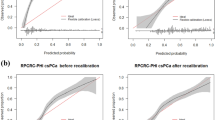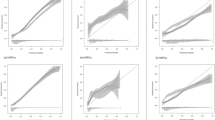Abstract
Purpose
This study aims to externally validate the Rotterdam Prostate Cancer Risk Calculator (RPCRC)-3/4 and RPCRC-MRI within a Dutch clinical cohort.
Methods
Men subjected to prostate biopsies, between 2018 and 2021, due to a clinical suspicion of prostate cancer (PCa) were retrospectively included. The performance of the RPCRC-3/4 and RPCRC-MRI was analyzed in terms of discrimination, calibration and net benefit. In addition, the need for recalibration and adjustment of risk thresholds for referral was investigated. Clinically significant (cs) PCa was defined as Gleason score ≥ 3 + 4.
Results
A total of 1575 men were included in the analysis. PCa was diagnosed in 63.2% (996/1575) of men and csPCa in 41.7% (656/1575) of men. Use of the RPCRC-3/4 could have prevented 37.3% (587/1575) of all MRIs within this cohort, thereby missing 18.3% (120/656) of csPCa diagnoses. After recalibration and adjustment of risk thresholds to 20% for PCa and 10% for csPCa, use of the recalibrated RPCRC-3/4 could have prevented 15.1% (238/1575) of all MRIs, resulting in 5.3% (35/656) of csPCa diagnoses being missed. The performance of the RPCRC-MRI was good; use of this risk calculator could have prevented 10.7% (169/1575) of all biopsies, resulting in 1.2% (8/656) of csPCa diagnoses being missed.
Conclusion
The RPCRC-3/4 underestimates the probability of having csPCa within this Dutch clinical cohort, resulting in significant numbers of csPCa diagnoses being missed. For optimal performance of a risk calculator in a specific cohort, evaluation of its performance within the population under study is essential.


Similar content being viewed by others
References
Petersmann AL, Remmers S, Klein T et al (2021) External validation of two MRI-based risk calculators in prostate cancer diagnosis. World J Urol 39(11):4109–4116. https://doi.org/10.1007/s00345-021-03770-x
Mottet N, van den Bergh RCN, Briers E et al (2021) EAU-EANM-ESTRO-ESUR-SIOG Guidelines on Prostate Cancer-2020 update. Part 1: screening, diagnosis, and local treatment with curative intent. Eur Urol 79(2):243–262. https://doi.org/10.1016/j.eururo.2020.09.042
Van Poppel H, Hogenhout R, Albers P et al (2021) Early detection of prostate cancer in 2020 and beyond: facts and recommendations for the European Union and the European Commission. Eur Urol 79(3):327–329. https://doi.org/10.1016/j.eururo.2020.12.010
Van Poppel H, Hogenhout R, Albers P et al (2021) A European Model for an organised risk-stratified early detection programme for prostate cancer. Eur Urol Oncol 4(5):731–739. https://doi.org/10.1016/j.euo.2021.06.006
Roobol MJ, Steyerberg EW, Kranse R et al (2010) A risk-based strategy improves prostate-specific antigen-driven detection of prostate cancer. Eur Urol 57(1):79–85. https://doi.org/10.1016/j.eururo.2009.08.025
Alberts AR, Schoots IG, Bokhorst LP et al (2016) Risk-based patient selection for magnetic resonance imaging-targeted prostate biopsy after negative transrectal ultrasound-guided random biopsy avoids unnecessary magnetic resonance imaging scans. Eur Urol 69(6):1129–1134. https://doi.org/10.1016/j.eururo.2015.11.018
Alberts AR, Roobol MJ, Verbeek JFM et al (2019) Prediction of high-grade prostate cancer following multiparametric magnetic resonance imaging: improving the Rotterdam European Randomized Study of screening for prostate cancer risk calculators. Eur Urol 75(2):310–318. https://doi.org/10.1016/j.eururo.2018.07.031
van Vugt HA, Roobol MJ, Kranse R et al (2011) Prediction of prostate cancer in unscreened men: external validation of a risk calculator. Eur J Cancer 47(6):903–909. https://doi.org/10.1016/j.ejca.2010.11.012
Chiu PK, Roobol MJ, Nieboer D et al (2017) Adaptation and external validation of the European randomised study of screening for prostate cancer risk calculator for the Chinese population. Prostate Cancer Prostatic Dis 20(1):99–104. https://doi.org/10.1038/pcan.2016.57
Püllen L, Radtke JP, Wiesenfarth M et al (2020) External validation of novel magnetic resonance imaging-based models for prostate cancer prediction. BJU Int 125(3):407–416. https://doi.org/10.1111/bju.14958
Cavadas V, Osório L, Sabell F et al (2010) Prostate cancer prevention trial and European randomized study of screening for prostate cancer risk calculators: a performance comparison in a contemporary screened cohort. Eur Urol 58(4):551–558. https://doi.org/10.1016/j.eururo.2010.06.023
Osses DF, Alberts AR, Bausch GCF et al (2018) Multivariable risk-based patient selection for prostate biopsy in a primary health care setting: referral rate and biopsy results from a urology outpatient clinic. Transl Androl Urol 7(1):27–33. https://doi.org/10.21037/tau.2017.12.11
Barentsz JO, Richenberg J, Clements R et al (2012) ESUR prostate MR guidelines 2012. Eur Radiol 22(4):746–757. https://doi.org/10.1007/s00330-011-2377-y
Turkbey B, Rosenkrantz AB, Haider MA et al (2019) Prostate imaging reporting and data system version 2.1: 2019 update of prostate imaging reporting and data system version 2. Eur Urol 76(3):340–351. https://doi.org/10.1016/j.eururo.2019.02.033
de Rooij M, Israël B, Tummers M et al (2020) ESUR/ESUI consensus statements on multi-parametric MRI for the detection of clinically significant prostate cancer: quality requirements for image acquisition, interpretation and radiologists’ training. Eur Radiol 30(10):5404–5416. https://doi.org/10.1007/s00330-020-06929-z
van Leenders GJLH, van der Kwast TH, Grignon DJ et al (2020) The 2019 International Society of Urological Pathology (ISUP) consensus conference on grading of prostatic carcinoma. Am J Surg Pathol 44(8):e87–e99. https://doi.org/10.1097/PAS.0000000000001497
Steyerberg EW, Vickers AJ, Cook NR et al (2010) Assessing the performance of prediction models: a framework for traditional and novel measures. Epidemiology 21(1):128–138. https://doi.org/10.1097/EDE.0b013e3181c30fb2
Vickers AJ, Elkin EB (2006) Decision curve analysis: a novel method for evaluating prediction models. Med Decis Making 26:565–574. https://doi.org/10.1177/0272989X06295361
Miller ME, Hui SL, Tierney WM (1991) Validation techniques for logistic regression models. Stat Med 10(8):1213–1226. https://doi.org/10.1002/sim.4780100805
Reesink DJ, Schilham MGM, van der Hoeven EJRJ et al (2021) Comparison of risk-calculator and MRI and consecutive pathways as upfront stratification for prostate biopsy. World J Urol 39(7):2453–2461. https://doi.org/10.1007/s00345-020-03488-2
Remmers S, Kasivisvanathan V, Verbeek JFM et al (2021) Reducing biopsies and magnetic resonance imaging scans during the diagnostic pathway of prostate cancer: applying the rotterdam prostate cancer risk calculator to the PRECISION trial data. Eur Urol Open Sci 36:1–8. https://doi.org/10.1016/j.euros.2021.11.002
Schoots IG, Roobol MJ (2020) Multivariate risk prediction tools including MRI for individualized biopsy decision in prostate cancer diagnosis: current status and future directions. World J Urol 38(3):517–529. https://doi.org/10.1007/s00345-019-02707-9
Ahdoot M, Wilbur AR, Reese SE et al (2020) MRI-targeted, systematic, and combined biopsy for prostate cancer diagnosis. N Engl J Med 382(10):917–928. https://doi.org/10.1056/NEJMoa1910038
Gayet M, Mannaerts CK, Nieboer D et al (2018) Prediction of prostate cancer: external validation of the ERSPC risk calculator in a contemporary Dutch clinical cohort. Eur Urol Focus 4(2):228–234. https://doi.org/10.1016/j.euf.2016.07.007
Xiang J, Yan H, Li J, Wang X, Chen H, Zheng X (2019) Transperineal versus transrectal prostate biopsy in the diagnosis of prostate cancer: a systematic review and meta-analysis. World J Surg Oncol 17(1):31. https://doi.org/10.1186/s12957-019-1573-0
Hagens MJ, Fernandez Salamanca M, Padhani AR et al (2022) Diagnostic performance of a magnetic resonance imaging-directed targeted plus regional biopsy approach in prostate cancer diagnosis: a systematic review and meta-analysis. Eur Urol Open Sci 40:95–103. https://doi.org/10.1016/j.euros.2022.04.001
Gayet MCW, van der Aa AAMA, Beerlage HP et al (2020) Cancer detection rates of systematic and targeted prostate biopsies after biparametric MRI. Prostate Cancer 2020:4626781. https://doi.org/10.1155/2020/4626781
Sugano D, Kaneko M, Yip W et al (2021) Comparative effectiveness of techniques in targeted prostate biopsy. Cancers (Basel) 13(6):1449. https://doi.org/10.3390/cancers13061449
Khoo CC, Eldred-Evans D, Peters M et al (2021) A comparison of prostate cancer detection between visual estimation (cognitive registration) and image fusion (software registration) targeted transperineal prostate biopsy. J Urol 205(4):1075–1081. https://doi.org/10.1097/JU.0000000000001476
Funding
No funding was received to assist with the preparation of this manuscript.
Author information
Authors and Affiliations
Contributions
MJH: protocol/project development, data collection or management, manuscript writing/editing. PJS: protocol/project development, data collection or management, manuscript writing/editing. HV: manuscript writing/editing. SPR: manuscript writing/editing. MS: manuscript writing/editing. VvdN: manuscript writing/editing. TAR: manuscript writing/editing. JvK: manuscript writing/editing. SR: data analysis, manuscript writing/editing. MJR: manuscript writing/editing. PJvL: protocol/project development, manuscript writing/editing. HGvdP: protocol/project development, manuscript writing/editing.
Corresponding author
Ethics declarations
Conflict of interest
The authors have no relevant financial or non-financial interests to disclose.
Ethical approval
This research study was conducted retrospectively from data obtained for clinical purposes. We consulted extensively with the Institutional Review Board (IRB) who determined that our study did not need ethical approval. An IRB official waiver of ethical approval was granted from the IRB (IRBd21-173).
Additional information
Publisher's Note
Springer Nature remains neutral with regard to jurisdictional claims in published maps and institutional affiliations.
Supplementary Information
Below is the link to the electronic supplementary material.
Rights and permissions
Springer Nature or its licensor holds exclusive rights to this article under a publishing agreement with the author(s) or other rightsholder(s); author self-archiving of the accepted manuscript version of this article is solely governed by the terms of such publishing agreement and applicable law.
About this article
Cite this article
Hagens, M.J., Stelwagen, P.J., Veerman, H. et al. External validation of the Rotterdam prostate cancer risk calculator within a high-risk Dutch clinical cohort. World J Urol 41, 13–18 (2023). https://doi.org/10.1007/s00345-022-04185-y
Received:
Accepted:
Published:
Issue Date:
DOI: https://doi.org/10.1007/s00345-022-04185-y




